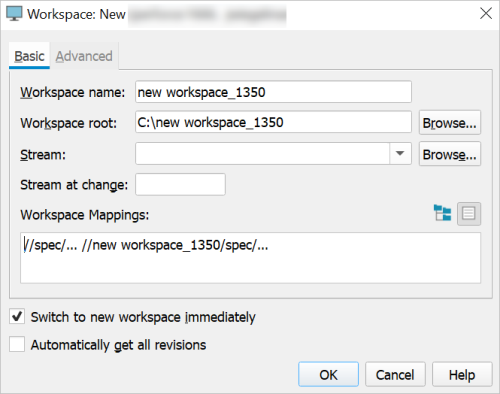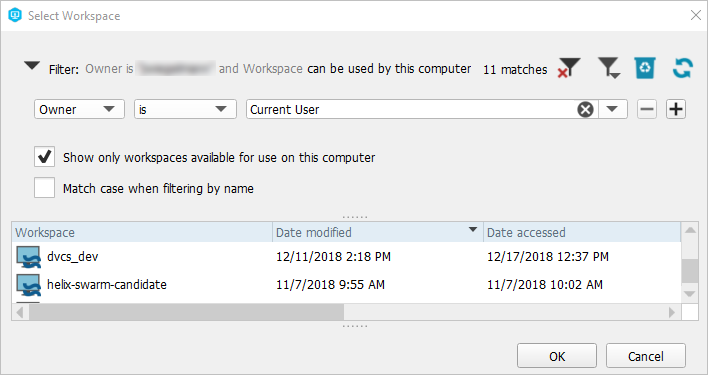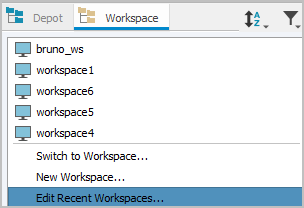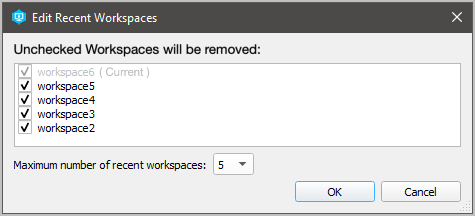Creating and managing workspaces
About workspaces
Your Helix server administrator can set up your workspace for you, but it is advisable to learn about configuring the workspace root directory and workspace specification (or "view").
The workspace root, also referred to as client root![]() The topmost (root) directory of a client workspace. If two or more client workspaces are located on one machine, they should not share a client root directory., specifies the location on your workstation under which Helix server stores copies of depot files. Give it a meaningful name and make sure it is not set to your computer's root directory.
The topmost (root) directory of a client workspace. If two or more client workspaces are located on one machine, they should not share a client root directory., specifies the location on your workstation under which Helix server stores copies of depot files. Give it a meaningful name and make sure it is not set to your computer's root directory.
A workspace specification defines the portion of the depot that can be
accessed from that workspace and specifies where local copies of files in
the depot are stored. Users of P4V call this location the workspace![]() Directories on your machine where you work on file revisions that are managed by Helix server. By default, this name is set to the name of the machine on which your client workspace is located, but it can be overridden. Client workspaces, labels, and branch specifications cannot share the same name.. (Users of the he
Helix Core server command line call this location the client.)
Directories on your machine where you work on file revisions that are managed by Helix server. By default, this name is set to the name of the machine on which your client workspace is located, but it can be overridden. Client workspaces, labels, and branch specifications cannot share the same name.. (Users of the he
Helix Core server command line call this location the client.)
A computer can contain multiple workspaces. Although P4V can connect to the server using only host name and port, a workspace is required to work with files that the Helix server manages.
The mapping of depot files to local files is called the workspace
view![]() A set of mappings that specifies the correspondence between file locations in the depot and the client workspace.. If you are working with streams, the workspace view is
generated by
Helix server, based
on the structure of the stream. If the structure of the stream changes,
the workspace view is updated automatically. You cannot manually edit a stream's workspace view. If you use a classic depot
A set of mappings that specifies the correspondence between file locations in the depot and the client workspace.. If you are working with streams, the workspace view is
generated by
Helix server, based
on the structure of the stream. If the structure of the stream changes,
the workspace view is updated automatically. You cannot manually edit a stream's workspace view. If you use a classic depot![]() A repository of Helix server files that is not streams-based. Uses the Perforce file revision model, not the graph model. The default depot name is depot. See also default depot, stream depot, and graph depot.,
a graph depot
A repository of Helix server files that is not streams-based. Uses the Perforce file revision model, not the graph model. The default depot name is depot. See also default depot, stream depot, and graph depot.,
a graph depot![]() A depot of type graph that is used to store Git repos in the Helix server. See also Helix4Git and classic depot., or a hybrid workspace
A depot of type graph that is used to store Git repos in the Helix server. See also Helix4Git and classic depot., or a hybrid workspace![]() A workspace that maps to files stored in a depot of the classic Perforce file revision model as well as to files stored in a repo of the graph model associated with git., you must define and maintain the
workspace view manually.
A workspace that maps to files stored in a depot of the classic Perforce file revision model as well as to files stored in a repo of the graph model associated with git., you must define and maintain the
workspace view manually.
- Helix server streams provide structured branching for version control of related files, such as codelines. Streams affect the way you create depots, define client workspaces, and integrate changes between files. See Working with streams.
- For information about graph depots and hybrid workspaces, see Working with graph depots.
Create a workspace
When you create a new workspace, P4V immediately creates the workspace directory. (In versions prior to 2019.1, P4V would only create the directory when you synced files for the first time.)
To create a new workspace:
-
Use of the following three alternatives:
-
On the top menu, choose Connection > New Workspace.
- In the Streams tab (in the right pane), right-click a stream and select New Workspace.
- In the Workspaces tab (in the right pane), right-click and select New Workspace.
-
-
If P4V is configured to prompt for a new workspace name, the Workspace Name dialog appears. Enter a name and click OK.
Otherwise, in the Workspace dialog, on the Basic tab, accept or change the default workspace name and root.
-
Map the workspace to the depot:
Classic depots (free-form branching):
Configure the workspace view (mappings) in the Workspace Mappings field by doing one of the following:
- Select the View workspace mapping as text icon
 and enter your
view specification using
Helix server
client view syntax.
and enter your
view specification using
Helix server
client view syntax. -
Select the View workspace mapping as tree icon
 and browse to
the files and folders you want.
and browse to
the files and folders you want.Build your workspace mapping by selecting a depot, folder, or file and using the Include
 , Exclude
, Exclude  , and Clear
, and Clear  buttons above the field.
buttons above the field.
Alternatively, right-click and select the Include, Exclude, and Clear options in the context menu.
For more information about mapping workspaces, including an example, see Define a workspace view.
Stream depots (structured branching):
-
Stream: Enter or browse for the stream that will be associated with this workspace.
If you enter a stream, the workspace view is populated automatically under Workspace Mappings; you cannot edit it.
NoteTo dissociate a workspace from a stream, delete the entry in the Stream field.
-
Stream at change: If you want to work using a stream definition as of a specific changelist, enter the changelist number here.
When a change is made to a stream definition, the stream is versioned using the current value of the change counter. Use Stream at change when you want your stream workspace to use a view generated from the stream definition as of a prior changelist.
Using a stream-at-change view is useful if you need to work with a set of directories and files that are not identical to the set in the current stream. For example, your stream may no longer include certain libraries that were included in an early version of the stream, but now you need those libraries to test a build. Enter the number of the last changelist to include those libraries. When you work in this workspace, P4V syncs to that changelist, allowing you to perform the test builds. Stream-at-change workspaces are read-only; you cannot check files into a previous changelist.
For more information about streams, see the "Streams" chapter in the Helix Core Server User Guide.
- Select the View workspace mapping as text icon
-
Specify the following settings on the Advanced tab as needed.
Owner
The user who created the specification.
Locked
If selected, only the owner of the workspace can use, change, or delete the workspace specification. Other users can see the workspace, but they cannot edit or delete its spec or use it to sync, open files, or do anything else.
Description
Your own explanation of the purpose of the workspace, or any related information you need to specify.
The Description field accepts HTML tags for marking up and hyperlinking text. For details, see Formatting text in Description fields.
Host
(Optional) The computer where the workspace resides. To enable the workspace to be used from any machine, leave this field blank.
AltRoots
For workspace specifications used from hosts on different platforms, a list of workspace roots in host-platform-specific syntax.
File Options
- Allwrite: All files in the workspace are writable (can be modified).
- Clobber: Syncing files overwrites writable files on the workspace.
- Compress: Compresses data sent between the workspace and Helix server.
- Modtime: Modification time for files edited in the client workspace is set to the time when the file is submitted to the depot. With this option, P4V also minimizes costly digest computations on the client by checking file modification times before checking digests to determine if files have been modified outside of P4V.
- Rmdir: Deletes a workspace folder if all the files contained in the folder are removed.
Line ending characters for text files
The line-end convention used for storing text files on the workspace computer:
- Local: Uses the workspace platform default
- Unix: LF
- Mac: CR
- Win: CRLF
- Share: Line endings are LF. Any CR prior to a line ending is removed for storage or syncing (for disks shared between UNIX and Windows)
On submit
Configures what happens when users submit files. The following options are available:
- Submit all selected files: Default. All open files are submitted.
- Don't submit unchanged files: Files that have content, type, or resolved changes are submitted, Unchanged files are moved to the default changelist.
- Revert unchanged files: Files that have content, type, or resolved changes are submitted. Unchanged files are reverted.
Check out submitted files after submit
If selected, P4V reopens submitted files in the default changelist.
Client type
Specifies the type of client:
writeableThe default.
readonlyfor short lived clients used in build automation scripts. Such clients cannot edit or submit files.
partitionedsimilar to readonly but with the additional ability to edit and submit files using that client.
NoteUsing writeable clients in build automation scripts can fragment the
db.havetable, which records the files that a client has synced. If you are experiencing performance issues when syncing, consider using use a read-only or partitioned client. A client of typereadonlyorpartitionedis assigned its owndb.havetable. The location of this table must first be specified with theclient.readonly.dirconfigurable by an administrator. See also "Using read-only and partitioned clients in automated builds" in Helix Core Server Administrator GuideBackup
Not currently in use. Applies only to clients bound to cluster workspace servers. Server clustering is no longer supported in Helix server. For additional information, see the Perforce Server Clustering Update.
- Click Save to save your entries and create the workspace specification.
Define a workspace view
The workspace view determines which portions of the depot are visible in your Workspace tab (in the left pane) and where local copies of depot files are stored in your workspace. If you use streams, the workspace view is generated and updated automatically. If you use classic depots, you must maintain the view manually, as described here.
To define or change your workspace view:
-
If the Workspace form is not already open, do the following:
- Go to View > Workspaces to open the Workspaces tab.
- In the Workspaces tab, right-click the workspace and select Edit Workspace.
-
In the Workspace dialog, edit the Workspace Mappings field.
You can define the view syntactically and graphically, as described in Syntactic view specification and Graphical view specification.
- When you have finished editing, save your changes.
Syntactic view specification
In the Workspace dialog, on the Basic tab, above the Workspace Mappings field, click the View workspace mapping as text  icon and type your view specification using
Helix server
client view syntax. Views consist of mappings, one per line. The
left-hand side of the mapping specifies the depot files and the
right-hand side specifies the location in the workspace where the depot
files reside when they are retrieved from the depot. The following example illustrates this.
icon and type your view specification using
Helix server
client view syntax. Views consist of mappings, one per line. The
left-hand side of the mapping specifies the depot files and the
right-hand side specifies the location in the workspace where the depot
files reside when they are retrieved from the depot. The following example illustrates this.
The workspace path provided includes the workspace name (bruno), not the workspace root (C:\Users\Perforce\bruno).
//depot/... //bruno/depot/...
//user_depot/... //bruno/user_depot/...
//projects/... //bruno/myprojects/...
For details about client view syntax, see the Configure clients chapter in the Helix Core Server User Guide.
Graphical view specification
Click the View workspace mapping as tree icon  . The depot is displayed as a tree of folders and
files. Right-click the file or folder you want to map and choose the
mapping, as follows:
. The depot is displayed as a tree of folders and
files. Right-click the file or folder you want to map and choose the
mapping, as follows:
- Include tree/Exclude tree: Include or exclude all files below the selected folder.
- Include file/Exclude file: Include or exclude a specific file.
- Include Special/Exclude Special: Use depot syntax to specify the workspace view.
- Clear: Remove mapped folders or files from the mapping.
Alternately, double-click files or folders and use the resulting Special Edit dialog to define the view. This dialog enables you to specify options by clicking radio buttons or using the Expressions field to enter the left and right-hand components of a client view mapping.
To quickly add a depot path to the client view, go to Search > Filter Depot > Entire Depot Tree, right-click the desired folder in the Depot Tree, and choose Map to Workspace View.
Switch workspaces
How to change from one workspace to another depends on whether you work with classic depots or streams.
Classic depots
When working with classic depots, you can switch your workspace using the Select Workspace dialog. To open the Select Workspace dialog, do any of the following:
- In the drop-down list at the top of the tree pane, click the drop-down arrow and select Switch to Workspace.
- Go to Connections > Switch to Workspace.
- Open the Open Connection dialog and click Browse next to the Workspace field.

You can also switch your workspace by right-clicking a workspace in the Workspaces tab (on the right) and selecting Switch to Workspace <workspace name>.
Stream depots
When working with streams, you can switch workspaces using the same methods you use when working with classic depots. In addition, you can switch stream workspaces by merging or copying to a stream (in this case, P4V prompts you to switch to the target stream's workspace), or by doing the following:
-
In the Streams tab or the Stream Graph, right-click a stream and select Work in this Stream.
- In the Stream Graph, drag the Workspace
 icon from your current
stream to the one you want to work in.
icon from your current
stream to the one you want to work in.
If your stream preferences are set to use a different workspace and to show an information dialog when switching workspaces, P4V prompts you to switch workspaces or create a new workspace. In this case, click the Create New Workspace button (if you have only one workspace), Switch Workspaces button (if you have two workspaces), or the Select Workspaces button (if you have more than two workspaces) to switch your workspace. If more than one workspace is associated with the stream, the Select Workspace dialog opens, where you can search for and select the workspace you want.
If your preferences are set to use the same workspace when you switch between streams, the workspace view changes to include the stream you are switching to. In other words, the Stream field value in the workspace definition changes to the new stream. When you do this and your Helix server version is 2019.1 or later, then if you have files checked out to:
- The default changelist: P4V shelves them automatically in a numbered changelist with the description "Switched branch shelf" and unshelves them again to the default changelist when you switch back to that stream. However, note that the numbered changelist created for the interim shelf does not get deleted and remains in the system.
- A numbered changelist:P4V prompts you to shelve those files before switching. When you switch back to that stream, those files remain shelved in the numbered changelist. You have to unshelve them manually.
If you reuse a workspace between streams and you have checked out the stream, you cannot switch streams. You first need to check in the stream. See also Edit a stream privately.
Edit recent workspaces
- Open the workspace list:

- Click Edit Recent Workspaces...

- To remove a workspace, unselect its check box.

Note that the current workspace cannot be removed.
To change the Maximum number of recent workspaces to display on the workspace list, select a value from the drop-down list.
View workspaces
To view workspaces for the server to which you are connected, do one of the following:
-
Go to View > Workspaces. Then double-click a workspace row in the Workspaces tab to display the details of the client workspace specification.
-
Open the Select Workspace dialog (for details, see Switch workspaces). Then double-click a workspace row to display the details of the client workspace specification.
Search for workspaces
You can use filters to search for workspaces in the Workspaces tab and the Select Workspace dialog. You can filter workspaces by any combination of the following:
- Owner: Select current user or enter a user ID.
- Workspace Name
- Stream name
You can also choose to Show only workspaces available for use on this computer.
For more information on filters, see Searching and filtering.
Delete and unload workspaces
Deleting a workspace removes the Helix server record of the workspace but does not remove files from the workspace or depot. You cannot delete a workspace that has files checked out (open for edit) in P4V.
Unloading transfers infrequently used metadata from the versioning engine’s database files to a set of flat files in an unload depot. If you unload a workspace, you can reload it if you change your mind and want to use it again.
To delete a workspace:
- Submit or revert any pending or shelved changelists associated with the workspace.
- Go to View > Workspaces to open the Workspaces tab.
- Right-click the workspace and select Delete Workspace 'workspace_name'.
To unload a workspace:
- Submit or revert any pending or shelved changelists associated with the workspace.
- Go to View > Workspaces to open the Workspaces tab.
- Right-click the workspace and select Unload Workspace 'workspace_name''.
To reload an unloaded workspace:
- Go to View > Workspaces to open the Workspaces tab.
- Select the Unloaded icon
 in the filter pane to open the Unloaded Workspaces dialog, where you
can filter for and select unloaded workspaces to reload.
in the filter pane to open the Unloaded Workspaces dialog, where you
can filter for and select unloaded workspaces to reload. - Right-click the workspace and select Reload Workspace 'workspace_name'.
For more information about unloading, see the p4 unload command in the Helix Core P4 Command Reference.






